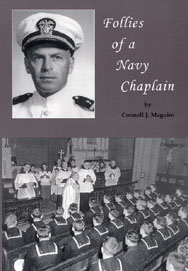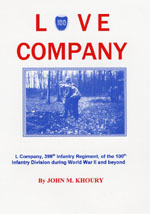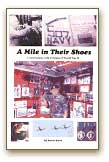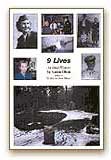The online edition
©2014, Aaron Elson
Baptism of Fire
Bob Hagerty
Bob Hagerty of Cincinnati was a sergeant in A Company, and later received a battlefield commission
It's funny, you remember not the tragic things, like when you see somebody who just died, because no matter how much you mourn him you're not going to bring him back. What you tend to think of is the goofy things. Like the time, I think Big Andy [Bob Anderson] was my tank driver, and we were supporting the infantry. We came across a little clearing, and I remember we came to some small trees, and I had to urinate. We didn't see anything out in front of us. I said, "Andy, hold it right here, I'm gonna get out a minute," and I jumped out and started to urinate right by the tracks.
A couple of the other guys decided to get out of the tank as well. And we all were about half-finished when we heard some small arms fire. There were Germans, we hadn't seen them. Whatever we were doing, the process stopped right there. We jumped onto the back of the turret, and we had the turret between us and them, we were able to duck inside the tank. You know, that's so many years atgo, but I still remember that. Or a time right after we'd been committed in France, I think it was even before the first person in the battalion was killed, and our tanks were being brought up to a certain place in support of the 82nd Airborne. They were dug in, and they fancied themselves as super soldiers. They had these distinctive outfits, and they carried grenades hooked onto their uniform legs, and they had big knives, they said they killed quietly rather than shooting, so it all sounded very grizzly. We were supposed to take our platoon of tanks -- Ed Forrest was our platoon leader -- into position just slightly behind where the infantry would be. That meant we had to go up a little dirt road and make a turn onto a smaller dirt road and that would bring us into position.
Forrest went first, then the No. 2 tank, the No. 3, and I was No. 4, I was the platoon sergeant. Somebody had told Forrest, "Look, when you go up this road and you take the right turn, hit the gas, don't worry about sliding around the turn or maybe running into some small saplings, hit the gas, because there's a German gun that's trained on the road.
So he goes up, and gets around there, and he goes over where this infantry position is, and No. 2 goes up, and No. 3 goes up, and then I went up, and as I made the turn, I heard this loud metallic sound, but the tank kept moving, so I thought, "We haven't been hit?" Then the No. 5 tank came along behind me.
When we got up behind the infantry, and we got out to see if anything had happened, there was a big hole in an apparatus on the back end of the tank that was useful for a tank that was discharged into the water, it redirected your exhaust portals. What the German had done, he'd fired as I rounded that corner, and his shell went through this shield. We were a millisecond away from him penetrating our tank.
People who knew said, "Oh, that was an 88." You could tell by the size of the hole. Well, an 88 was big enough to knock out our tanks any day in the week.
After that, the guys in the company who hadn't yet been exposed to battle, you know, they didn't have any war stories -- they were gonna have damn shortly, but they didn't have them then -- they could say, "Look at Hagerty's tank, look at that hole."
George Bussell
We still had those big shrouds on the tanks from landing in the water. Hagerty was the tank commander and I was his driver. We were coming down this road, we stopped at this crossroad, and boy, one came in close. Because they had everything zeroed in.
I said to Bob, "We'd better move." So we moved on up to a hedgerow, and backed around so we could get a shot at anything coming.
I got out of the tank, and went back and was eating a sandwich. I leaned over on the tank with my hand, and in that shroud that comes up, just below the end of the tank, there was a big hole. That 88 went clear through it. I said to Bob, "That's pretty damn close, ain't it?"
And we were carrying Bangalore torpedoes on the back of the tank. They came in two pieces, and you could hook them together. Then instead of blowing up, they blew down. You could use them to blow a hole through a hedgerow. I saw that hole, it was inches from those Bangalore torpedoes. I said to Hagerty, "Look at that. I don't know about you, but I'm getting rid of these torpedoes." I threw 'em over the hedgerow. That was too close for comfort.
Jim Gifford
Lieutenant Jim Gifford joined the battalion as a replacement in Normandy.
After we landed at the beach, we got up into Ste. Mere Eglise, that was the first town that was in the process of being taken, and there were gliders all over the place. Loaded with gliders. Every field had gliders tipped up, turned over, there were ten, fifteen guys in the nose of them, still laying there, and all their equipment, dead. There were so many gliders that struck things and killed all the men in them. It was pathetic.
I walked up to a glider and I saw all these guys in there and there was nobody you could help, they were all dead, no question about it, some guys had spilled out on the ground.
I saw a Reader's Digest laying on the ground by a glider, and on the side of it, it had an American flag, about an inch wide. I cut that off the Reader's Digest, and I picked up a piece of plastic from the windshield of the glider.
Later, I took the handle off my .45 and I carved a new handle with the plastic, and I put the American flag from the Reader's Digest underneath it. I've still got the gun. It was on my hip all through the war. It was my buddy wherever I was, and I was damn well sure I was gonna bring it home. We were supposed to turn that stuff in when we got back. I said to hell with it, let them find me, I'm keeping this, and I've still got it. I even have a permit for it.
Smoky Stuever
My first mission was to retrieve an A Company tank that lost a track on Hill 122, a shell blew off some blocks of track.
On my way up there, the mortar fire started coming in pretty heavy, so I had my driver, Shorty [Marion Kubeczko], shut off the tank. I ran around behind the tank and dove underneath the engine. There was a limb about two inches in diameter, and I was hanging onto that, with my head turned sideways, and all of a sudden I look and there's a piece of shrapnel dug into that limb. When I saw that piece of hot metal smoking in that wood, I thought, "I've got to get out of here!" So I stood behind the tank and crouched over, I thought, well, the most I could do is lose a leg.
Then the mortar fire ceased and I saw where I had to go. I ran back to the tank retriever and I said, "Let's go." We got up there and I made a very quick surmise of it because the tank was right out in the open, and I told the men to bring in a section of five track blocks. It took us only ten minutes to change them and put the tank back on the road, and we got out of there.
The next day we had to go to the middle of Hill 122 and over to the right, where there was a D Company tank turned over in a ditch. We turned it over, and in order to get it out of there we had to tow it about a quarter of a mile farther up the road into an opening that looked like a picnic area.
There was a cottage there, and some of the guys went over and examined that cottage. My tank was towing the D Company tank, and as we backed it around, I stood behind a great big tree that was at least two feet in diameter, and directed the movements. Then the sniper fire got heavy, and the bark of the tree was peeling off right next to me, so I told Shorty to get out of there on the double, and as he went out I ran around the tank on the opposite side and I crawled onto it.
As we got down a little ways, the Army had laid a big, heavy smokescreen so the Germans couldn't see where I was, and right at that time one of the pins wobbled out of the towbar because one of the men didn't lock it with a cotter pin, and it vibrated out of there. The tank went back in the ditch and bent my towbar and it bent my patience.
We hooked it up again and pulled it into a group of apple trees and we shut it off, because the mortar fire was starting to come in quite heavy.
A little bit farther up ahead on the right side of the road was a big gravel pit, a stone quarry that they used for building roads. There was a bunch of foxholes in there that the Germans must have dug, and as I jumped into one of the foxholes, I saw this shiny piece of piano wire, and underneath some leaves was a German potato masher on the other end of that wire. I almost fainted, and I just rolled up out of that hole, and I couldn't yell or talk, I just pointed, and old Chap -- that's Sergeant Kochen -- saw me and he said, "What's the matter with you, Smoky?" And I kept pointing at that hole, I couldn't talk, and then I finally was able to say, "Don't go in there."
Then he saw it and said, "Everybody lay low." He threw a piece of a log into the foxhole, and it wasn't long before that piece flew out of there and it was shredded.
I finally regained my strength. I couldn't do anything. I had to go over by the tank, sit down, and drink some good old cider, because the water wasn't fit for humans, and I regained my ego, and we continued to fix that D Company tank.
Mike Anderson
Sergeant Mike Anderson, of Needham, Mass., drove one of the three 105-millimeter assault guns in Headquarters Company.
We were on a hardtop road, and we came by a farmhouse. I was in the first tank, and they let us go through. The second tank got hit and burned. That's the one in which Richard Howell was killed.
After we passed the farmhouse, we got into the orchard, and we were weaving back and forth around the trees. There was a German tank in the corner. He shot at us a couple of times. The first one hit the ground, and the second one knocked our track off. We fired back, and our first round went over it. The gunner dropped the barrel as far as he could and let the next round go, and it caught that German tank right under the big gun, right above where the driver was sitting.
After we got squared away, we walked over and looked at this tank. The driver was still in there, he was dead. The rest of the crew had jumped out and gone back. But they had another round in the gun, and that breach was almost closed completely. If they'd have closed it, I think that's the one that would have gotten us before we got them.
- - - -







